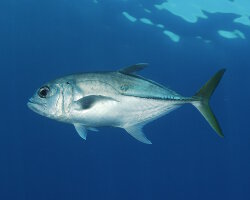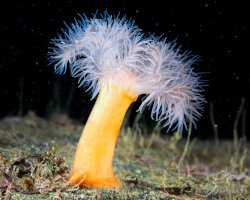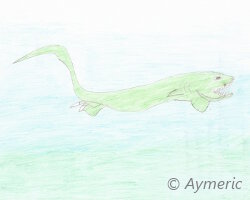Sealife guideThe hogfishLachnolaimus maximus
Taxonomy
- Common name: Hogfish
- French name: Poisson capitaine, labre capitaine
- Spanish name: Boquinete
- Scientific name: Lachnolaimus maximus (Walbaum, 1792)
- Family name: Labridae
- Order name: Perciformes
- Class name: Actinopterygii
Description
The hogfish is a large fish with a maximum length of around 31 to 35 inches. This fish is characterized by the presence of a series of three long, thin spines at the front of its dorsal fin.

The hogfish is characterized by a series of three long, thin spines at the front of its dorsal fin
These spines, located on the top of its head, aren't always noticeable at first glance because they are sometimes raised and sometimes curved along the body when it moves. Additionally, a large spot of darker color than the rest of its body runs along the top of its head. In some individuals, this spot may extend along the entire upper part of the body.
The hogfish has a flattened body with a dominant whitish-gray color. At the rear base of its dorsal fin, you can observe a small black spot. Its dorsal and anal fins end in a point, while its caudal fin is crescent-shaped and features a darker vertical band across its full height.
Juvenile hogfish are distinguished from adults by their marbled reddish-brown coloration.
Range
The hogfish is found in the western Atlantic ocean, from the coasts of Florida in the north to the coasts of Brazil in the south. It is also present along the coasts of Mexico and throughout the numerous islands scattered in the Caribbean sea, including
Guadeloupe, Cuba and the Bahamas.
Habitat
The hogfish primarily lives in shallow waters near coral reefs but also frequents depths of up to around 130 feet. The hogfish roams the sandy areas that border coral reefs.
Diet
The hogfish feeds on smaller fish, mollusks, crustaceans and sea urchins.

The hogfish roams the sandy areas that border coral reefs
Reproduction
The hogfish is a protogynous
hermaphrodite, meaning it changes sex during its life but only from female to male, typically between the ages of 3 to 5 years.
Did you know ?
The hogfish has been listed as a vulnerable species on the
IUCN Red List of Threatened Species since 1996. Its status was reviewed in 2010 but remained unchanged.
Hogfish populations are threatened by line fishing and spearfishing, particularly in Florida, where populations have significantly declined.
However, measures have been implemented regarding the size of captured fish, though the expected results have yet to fully materialize.
Tips for observing
Difficult to observe, the hogfish is not easily approached, especially since it usually moves in open territory in sandy areas surrounding coral reefs !

Solitary and active during the day, you can observe the hogfish alone searching for food, sifting through the surface sand with its mouth !
Solitary and active during the day, you can observe the hogfish alone, searching for food by sifting through the surface sand with its mouth, much like a « pig with its snout » ! It's this behavior that gives it its english name.
Within the same family
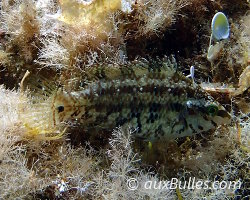
Five-spotted wrasse
(Symphodus roissali)

False leopard wrasse
(Macropharyngodon ornatus)
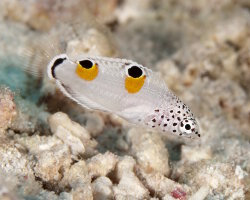
Clown coris
(Coris aygula)

Philippines wrasse
(Pseudocoris bleekeri)
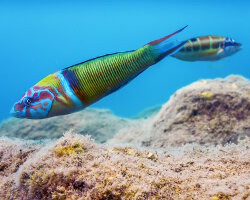
Ornate wrasse
(Thalassoma pavo)
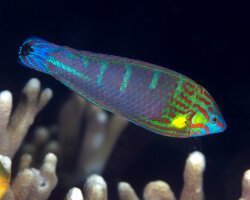
Tail-spot wrasse
(Halichoeres melanurus)

Pacific Diana's pigfish
(Bodianus dictynna)

Bird mouth wrasse
(Gomphosus varius)
Explore also

Humbug damselfish
(Dascyllus aruanus)

Orange spotted prawn goby
(Amblyeleotris guttata)
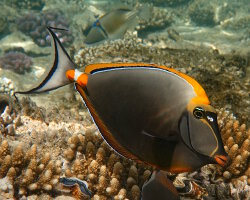
Orangespine unicornfish
(Naso lituratus)

Ornate butterflyfish
(Chaetodon ornatissimus)
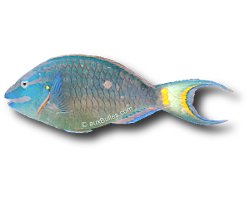
Stoplight parrotfish
(Sparisoma viride)
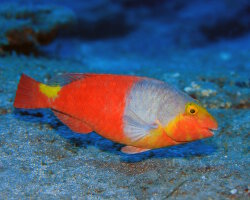
European parrotfish
(Sparisoma cretense)

Black breasted pipefish
(Corythoichthys nigripectus)

Bigeye tuna
(Thunnus obesus)
The marine species from Caribbean sea
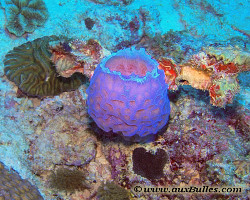
Azure vase sponge
(Callyspongia plicifera)
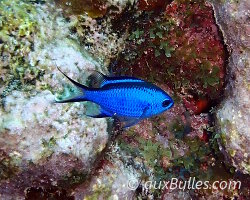
Blue chromis
(Azurina cyanea)
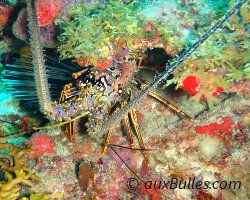
Caribbean spiny lobster
(Panulirus argus)
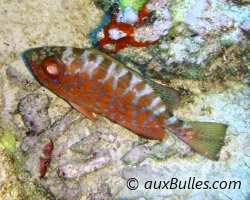
Glasseye snapper
(Heteropriacanthus cruentatus)

Long-spined sea urchin
(Diadema antillarum)
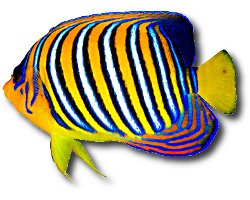
Royal angelfish
(Pygoplites diacanthus)
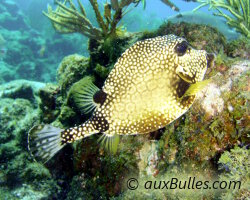
Smooth trunkfish
(Rhinesomus triqueter)
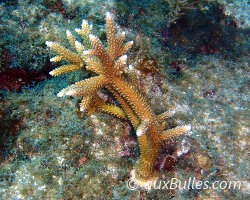
Staghorn coral
(Acropora cervicornis)
Dive centers
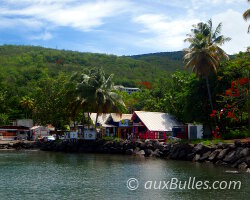
'Les Ilets' dive center
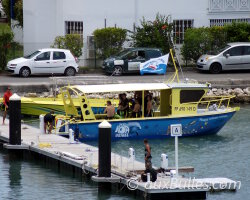
Noa dive center































